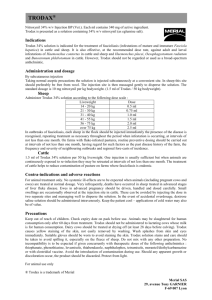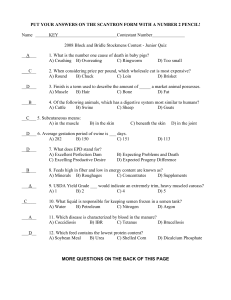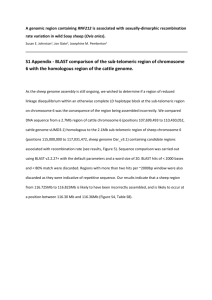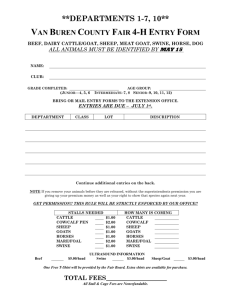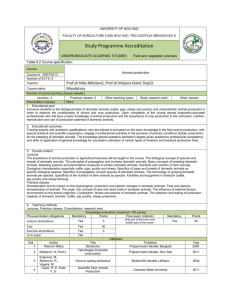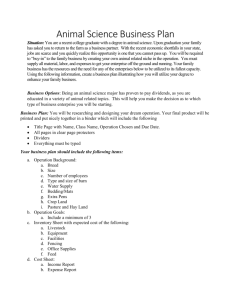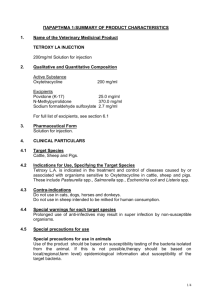Revised: February 2014 AN: 01529/2013 SUMMARY OF PRODUCT
advertisement
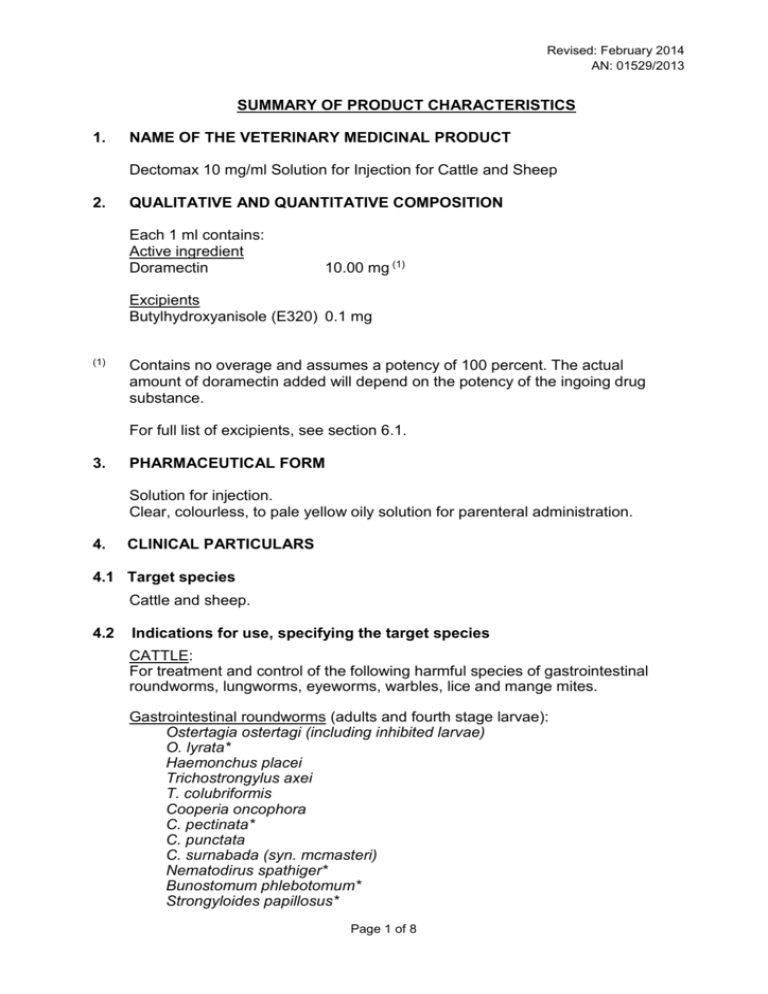
Revised: February 2014 AN: 01529/2013 SUMMARY OF PRODUCT CHARACTERISTICS 1. NAME OF THE VETERINARY MEDICINAL PRODUCT Dectomax 10 mg/ml Solution for Injection for Cattle and Sheep 2. QUALITATIVE AND QUANTITATIVE COMPOSITION Each 1 ml contains: Active ingredient Doramectin 10.00 mg (1) Excipients Butylhydroxyanisole (E320) 0.1 mg (1) Contains no overage and assumes a potency of 100 percent. The actual amount of doramectin added will depend on the potency of the ingoing drug substance. For full list of excipients, see section 6.1. 3. PHARMACEUTICAL FORM Solution for injection. Clear, colourless, to pale yellow oily solution for parenteral administration. 4. CLINICAL PARTICULARS 4.1 Target species Cattle and sheep. 4.2 Indications for use, specifying the target species CATTLE: For treatment and control of the following harmful species of gastrointestinal roundworms, lungworms, eyeworms, warbles, lice and mange mites. Gastrointestinal roundworms (adults and fourth stage larvae): Ostertagia ostertagi (including inhibited larvae) O. lyrata* Haemonchus placei Trichostrongylus axei T. colubriformis Cooperia oncophora C. pectinata* C. punctata C. surnabada (syn. mcmasteri) Nematodirus spathiger* Bunostomum phlebotomum* Strongyloides papillosus* Page 1 of 8 Revised: February 2014 AN: 01529/2013 Oesophagostomum radiatum Trichuris spp.* * adults Lungworms: (adults and fourth stage larvae) Dictyocaulus viviparus Eyeworms: (adults) Thelazia spp. Warbles: (parasitic stages) Hypoderma bovis H. lineatum Sucking lice: Haematopinus eurysternus Linognathus vituli Solenopotes capillatus Mange mites: Psoroptes bovis Sarcoptes scabiei May also be used as an aid in the control of Nematodirus helvetianus, biting lice (Damalinia bovis) and the mange mite Chorioptes bovis. The pharmacokinetics of Dectomax Solution for Injection allows protection of cattle against infection or re-infection with the following parasites for the period indicated: Species Days Ostertagia ostertagi Cooperia oncophora Dictyocaulus viviparus Bunostomum phlebotomum Oesophagostomum radiatum Trichostrongylus axei Linognathus vituli Psoroptes bovis Haemonchus placei 35 21 35 22 21 28 28 42 28 To obtain optimal benefits from the action of DECTOMAX Solution for Injection, it is recommended that cattle which are set-stocked should be treated at turnout and eight weeks later. Studies have demonstrated that, used in this way, DECTOMAX will reduce the build-up of infective larvae on pasture and can protect animals from parasitic gastro-enteritis and parasitic bronchitis throughout the grazing season. To obtain theses results, all animals must be included in the programme and untreated cattle must not be introduced on the pasture. Treated cattle should always be monitored according to good husbandry practices. Treatment with DECTOMAX Solution for Injection at turnout and eight weeks later of cattle set-stocked for the grazing season can protect against clinical disease caused by lungworm and may allow the Page 2 of 8 Revised: February 2014 AN: 01529/2013 development of naturally acquired immunity. However, due to the unpredictable nature of lungworm epidemiology, clinical signs of lungworm disease may on occasion be seen, particularly towards the end of the grazing season, if the season is long. If this occurs, cattle should be further treated with an anthelmintic effective against lungworm. SHEEP: For treatment and control of Psoroptes ovis (sheep scab mite) and for the treatment and control of gastrointestinal roundworms and nasal bots. Mange mites Psoroptes ovis Gastrointestinal roundworms (Adults and fourth stage larvae (L4) unless otherwise indicated): Chabertia ovina (adults only) Cooperia curticei (L4 only) C. oncophora Gaigeria pachycelis Haemonchus contortus Nematodirus battus (L4 only)1 Ostertagia (Teladorsagia) circumcincta * Oesophagostomum columbianum Strongyloides papillosus Trichostrongylus axei Trichostrongylus colubriformis Trichostrongylus vitrinus Trichuris spp (Adults only) * Inhibited larval stages (L4) including strains that are benzimidazole resistant, are also controlled. 1 For effective treatment and control of both adults and L4 larvae of Nematodirus battus a dose rate of 300 mcg/kg is required. Lungworms Dictyocaulus filaria (Adults only) Nasal bots (1st, 2nd and 3rd instar larvae) Oestrus ovis 4.3 Contraindications Extra-label use in dogs should be avoided, as severe adverse reactions may occur. In common with other avermectins, certain breeds of dog, such as collies, are especially sensitive to doramectin and particular care should be taken to avoid accidental consumption of the product. Page 3 of 8 Revised: February 2014 AN: 01529/2013 4.4 Special warnings for each target species Care should be taken to avoid the following practices because they increase the risk of development of resistance and could ultimately result in ineffective therapy: Too frequent and repeated use of anthelmintics from the same class, over an extended period of time. Underdosing, which may be due to underestimation of body weight, misadministration of the product, or lack of calibration of the dosing device (if any). Suspected clinical cases of resistance to anthelmintics should be further investigated using appropriate tests (e.g. Faecal Egg Count Reduction Test). Where the results of the test(s) strongly suggest resistance to a particular anthelmintic, an anthelmintic belonging to another pharmacological class and having a different mode of action should be used. Resistance to doramectin (an avermectin) has been reported in Teladorsagia and Haemonchus in sheep within the EU. Therefore, the use of this product should be based on local (regional, farm) epidemiological information about susceptibility of nematodes and recommendations on how to limit further selection for resistance to anthelmintics. 4.5 Special precautions for use (i) Special precautions for use in animals This product does not contain an antimicrobial preservative. Swab septum before removing each dose. Use sterile equipment and follow aseptic procedures. When treating groups of animals, use only the Dectomax automatic dosing device and vented draw-off apparatus. For the treatment of individual sheep a disposable 2 ml syringe calibrated in increments of 0.1 ml should be used. In young lambs of less than 16 kg bodyweight seek veterinary advice regarding the use of appropriate sized needles and of 1 ml disposable syringes graduated in increments of 0.1 ml or less. Syringes must be filled from the vial through a dry, sterile draw-off needle that has been placed in the vial stopper. Vial stoppers must not be broached more than 20 times. (ii) Special precautions to be taken by the person administering the veterinary medicinal product to animals Do not eat, drink or smoke while handling the product. Wash hands after use. Page 4 of 8 Revised: February 2014 AN: 01529/2013 Take care to avoid accidental self administration - seek medical attention should any specific signs be noticed. Advice to Medical Practitioners: In cases of accidental self injection specific symptoms have rarely been observed and therefore any cases should be treated symptomatically. (ii) Other precautions Doramectin is very toxic to dung fauna and aquatic organisms and may accumulate in sediments. The risk to aquatic ecosystems and dung fauna can be reduced by avoiding too frequent and repeated use of doramectin (and products of the same anthelmintic class) in cattle and sheep. The risk to aquatic ecosystems will be reduced by keeping treated cattle away from water bodies for two to five weeks after treatment. 4.6 Adverse reactions (frequency and seriousness) None known. 4.7 Use during pregnancy, lactation or lay May be used in pregnant cows and ewes. Do not use in pregnant cows or heifers, which are intended to produce milk for human consumption, within 2 months of expected parturition. Do not use in pregnant ewes, which are intended to produce milk for human consumption, within 70 days of expected parturition. 4.8 Interaction with other medicinal products and other forms of interaction None known. 4.9 Amounts to be administered and administration route To ensure administration of a correct dose, bodyweight should be determined as accurately as possible; accuracy of the dosing device should be checked. In cattle: A single treatment of 1 ml (10 mg doramectin) per 50 kg bodyweight, equivalent to 200 µg/kg bodyweight, administered in the region of the neck by subcutaneous injection. In sheep: A single treatment of 1 ml (10 mg doramectin) per 33 kg bodyweight, equivalent to 300 mcg/kg bodyweight, administered by intramuscular injection for the treatment and control of Psoroptes ovis (sheep scab mite) and adult Nematodirus battus. In addition, adequate bio-security measures should be implemented to prevent re-infestation. Ensure that all sheep which have been in contact with infested sheep are treated. After treatment, contact between treated infected and untreated uninfected flocks must be avoided for at least 14 days. A single treatment of 1 ml (10 mg doramectin) per 50 kg bodyweight, Page 5 of 8 Revised: February 2014 AN: 01529/2013 equivalent to 200 µg/kg bodyweight, administered by intramuscular injection for the control of certain other gastro-intestinal nematodes and nasal bots. 4.10 Overdose (symptoms, emergency procedures, antidotes), if necessary In cattle (SC route only) and sheep (IM route only) overdoses up to 25 and 10 times respectively the maximum label recommended dose resulted in no adverse clinical signs. 4.11 Withdrawal periods CATTLE: Meat and offal: 70 days Not permitted for use in lactating animals producing milk for human consumption. Do not use in pregnant cows or heifers, which are intended to produce milk for human consumption, within 2 months of expected parturition. SHEEP: Meat and offal: 70 days Not permitted for use in lactating animals producing milk for human consumption. Do not use in pregnant ewes, which are intended to produce milk for human consumption, within 70 days of expected parturition. 5. PHARMACOLOGICAL PROPERTIES 5.1 Pharmacodynamic properties Doramectin is a new fermentation-derived antiparasitic agent which belongs to the avermectin class, and is closely related structurally to ivermectin. Both compounds share a wide spectrum of antiparasitic activity and produce a similar paralysis in nematodes and parasitic arthropods. Whilst it is not possible to assign a single mode of action to the avermectins, it is likely that the entire series share a common mechanism. In parasitic organisms the effect is mediated through a specific avermectin binding site. The physiological response to avermectin binding is an increase in membrane permeability to chloride ions. In invertebrate nervous tissue an influx of chloride ions into the excitatory motor neurone in nematodes or muscle cell of arthropods results in hyperpolarisation and the elimination of signal transmission with resulting paralysis. Doramectin is exceptionally well-tolerated in mammals, where receptor/channel complexes are localised in the CNS. Poor penetration of large molecular weight compounds, such as avermectins, through the blood-brain barrier suggests that high systemic concentrations would be required before neurological function is affected. Page 6 of 8 Revised: February 2014 AN: 01529/2013 5.2 Pharmacokinetic particulars Maximum plasma concentration of doramectin occurs in cattle 3 days after subcutaneous administration of Dectomax Solution for Injection. In sheep the maximum plasma concentration of doramectin occurs 2 days after intramuscular administration of Dectomax Solution for Injection; in pigs 3 days after intramuscular administration. An elimination half-life of around 6 days for cattle, by the subcutaneous route, and 4.5 days for sheep, by the intramuscular route, results in sustained doramectin concentrations which protect cattle and sheep from parasitic infection and re-infection for extended periods following treatment. 5.3 Environmental properties Like other macrocyclic lactones, doramectin has the potential to adversely affect non-target organisms. Following treatment, excretion of potentially toxic levels of doramectin may take place over a period of several weeks. Faeces containing doramectin excreted onto pasture by treated animals may reduce the abundance of dung feeding organisms which may impact on the dung degradation. Doramectin is very toxic to aquatic organisms and may accumulate in sediments. 6. PHARMACEUTICAL PARTICULARS 6.1 List of excipients Butylhydroxyanisole (E320) Ethyl oleate Sesame oil 6.2 Incompatibilities None known. 6.3 Shelf life Shelf-life of the veterinary medicinal product as packaged for sale: 3 years. Shelf-life after first opening the immediate packaging: 6 months. 6.4. Special precautions for storage Do not store above 30°C. Do not freeze. Do not refrigerate. Protect from direct sunlight. Following withdrawal of the first dose, use the product within 6 months. 6.5 Nature and composition of immediate packaging Supplied in 50 ml, 250 ml and 500 ml multi-dose amber glass vials closed with a grey halogenated butyl rubber stopper with an aluminium overseal. Not all pack sizes may be marketed. Page 7 of 8 Revised: February 2014 AN: 01529/2013 6.6 Special precautions for the disposal of unused veterinary medicinal product or waste materials derived from the use of such products, if appropriate Any unused veterinary medicinal product or waste materials derived from such veterinary medicinal products should be disposed of in accordance with local requirements. EXTREMELY DANGEROUS to fish and aquatic life. Do not contaminate ponds, waterways or ditches with the product or used containers. 7. MARKETING AUTHORISATION HOLDER Elanco Animal Health Eli Lilly & Company Ltd Lilly House Priestley Road Basingstoke Hampshire RG24 9NL 8. MARKETING AUTHORISATION NUMBER Vm 00006/4121 9. DATE OF FIRST MARKETING AUTHORISATION Date: 5 August 1994 10 DATE OF REVISION OF THE TEXT Date: February 2014 07 March 2014 Page 8 of 8
